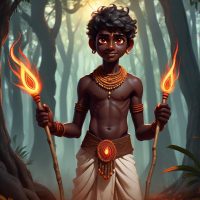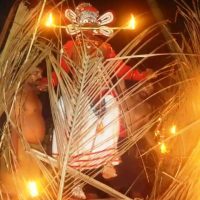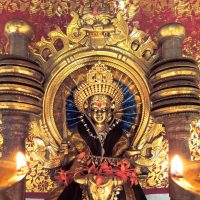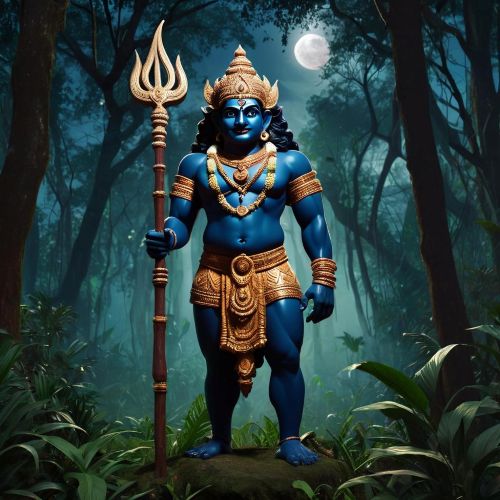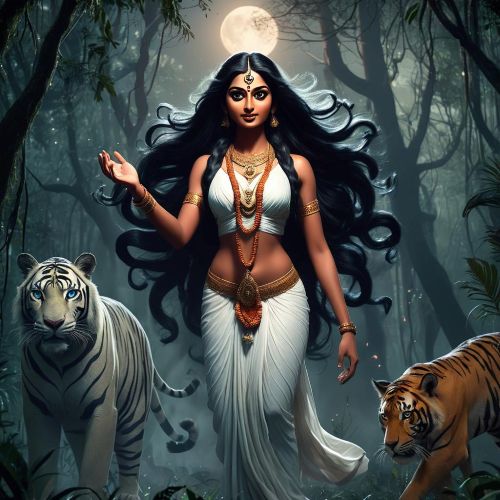Theekutti Chathan : The Fiery Trickster
Listen
At a glance
| Description | |
|---|---|
| Origin | Indian Mythology |
| Classification | Spirits |
| Family Members | N/A |
| Region | India |
| Associated With | Mischief, Fire |
Theekutti Chathan
Introduction
Theekutti Chathan, often associated with the more widely known Kuttichathan, is one of the most fascinating and mysterious figures in Kerala’s folklore. Known both as a mischievous prankster and a powerful protector, Theekutti Chathan occupies a unique space in South Indian mythology. The name itself combines “Thee” (fire) and “kutti” (child), emphasizing his fiery temperament and youthful form. Worship of Chathan is particularly prominent in central and northern Kerala, where his presence is invoked in Theyyam performances, tantric rituals, and temple traditions connected to Vishnumaya. Unlike many deities who are confined to a divine or purely benevolent role, Theekutti Chathan embodies duality: playful yet protective, feared yet adored, demonic yet divine. His myths, rituals, and cultural significance reveal how Kerala’s folklore seamlessly blends tribal, tantric, and classical Hindu traditions.
Physical Traits
Theekutti Chathan is usually imagined as a dark-skinned boy around the age of twelve, with a lively face and a mischievous smile. His hair is often tied in a knot on the crown, called a kutumi, and his body is sometimes shown adorned with sacred ash or symbolic markings. In many depictions, he carries a small stick (kuruvadi) and rides a buffalo, signifying strength and command over spirits.
Ritual performance traditions such as Theyyam bring his image to life in dramatic fashion. Performers wear intricate face paint, vibrant costumes dominated by red, and heavy headgear with wooden and metallic designs, representing both his childlike form and fiery energy. Some narratives describe him with three eyes, linking him to Shiva’s cosmic power, while others highlight features like horns or sharp teeth to represent his fearsome side. The combination of innocence and menace makes his visual representation distinct and unforgettable.
Family
The origins of Theekutti Chathan are recounted through multiple traditions, reflecting Kerala’s layered spiritual beliefs. The most popular legend identifies him as the son of Lord Shiva and Goddess Parvati. According to one tale, Parvati transformed into the tribal woman Koolivaka with the aid of Vishnu’s maya, leading to Chathan’s birth. Raised initially by Koolivaka, he later returned to Mount Kailash where his divine lineage was revealed.
Other versions describe Chathan as the result of Parvati’s ethereal energy, born specifically to defeat the demon Bhringasuran. In certain folk traditions, his story also intertwines with caste narratives—portraying him as a child of Brahmin men and women of lower castes, symbolizing taboo-breaking and societal tensions. Some myths claim that from his spilled blood during battles, hundreds of smaller spirits called Chathanmar were created, who serve him and expand his presence across Kerala’s spiritual practices.
This multiplicity of family origins underscores his role as a liminal figure—divine, tribal, and folkloric at once—bridging orthodox Hindu cosmology with local traditions.
Other names
Theekutti Chathan is known by different names depending on context and region. He is most commonly referred to as Kuttichathan, meaning “little spirit” or “child goblin.” When associated with Vishnu’s powers of illusion, he is worshipped as Vishnumaya Chathan, especially in temple contexts.
He is also called Karinkutti Chathan when portrayed in darker, more fearsome aspects, while names such as Pookutti Chathan and Parakkutti Chathan appear in regional variations, representing specific manifestations. Collectively, the spirits born from his mythic battles are called Chathanmar, each carrying a fragment of his energy.
In devotional worship, he is respectfully addressed as Chathan Swami, a term highlighting his divine authority rather than his mischie
Powers and Abilities
Theekutti Chathan is celebrated for his extraordinary powers, which straddle the boundary between benevolence and mischief. His foremost ability is maya, the power of illusion, through which he can create visions, deceive enemies, or protect his devotees. His command over reality allows him to appear in multiple forms, vanish suddenly, or multiply into countless spirits.
He is also associated with fire, which gives him his title “Theekutti.” Tales describe him setting clothes or huts ablaze as part of his mischievous acts or as punishment for neglectful worshippers. His supernatural strength made him capable of defeating formidable demons, and he is frequently portrayed as riding a buffalo, symbolizing control over untamed energies.
At the same time, Chathan is known for his playful pranks—moving objects, making eerie sounds at night, or unsettling households. While rarely dangerous, these acts serve as reminders of his presence and power. On the protective side, Theekutti Chathan shields devotees from curses, black magic, and hostile spirits. Rituals like Chathan Seva are performed to invoke his blessings for prosperity, health, and success. However, folklore warns that if rituals are performed incorrectly or with insincerity, the results can backfire, causing distress instead of protection.
Modern Day Influence
Theekutti Chathan continues to hold immense significance in Kerala’s cultural and spiritual practices. His worship thrives in temples dedicated to Vishnumaya Chathan, particularly in central Kerala, where devotees seek his help against adversities and black magic. Animal sacrifices, especially the offering of a rooster, remain part of traditional rituals aimed at appeasing him.
Theyyam performances in northern Kerala remain one of the most vibrant expressions of Chathan’s myth. These ritual dances, performed with music, costumes, and trance, dramatize his legendary battles and mischievous exploits, allowing the community to engage directly with his spirit. Such performances are both sacred ceremonies and cultural spectacles that preserve Kerala’s intangible heritage.
In popular culture, Chathan’s character has crossed into cinema and literature. The 1984 Malayalam film My Dear Kuttichathan—India’s first 3D film—introduced him to a wider audience as a magical companion to children, cementing his place in collective memory. More recently, Malayalam films like Kumari (2022) and Bhramayugham (2023) have revisited his myth through darker, more mystical interpretations. Comics and television shows often adapt him into friendly trickster figures, blending folklore with entertainment.
The presence of Theekutti Chathan has also migrated into digital culture. Folklore websites, YouTube channels, and social media accounts regularly share stories, Theyyam recordings, and ritual practices associated with him, ensuring that his myth is not only preserved but constantly reimagined for modern audiences. In rural Kerala, unexplained disturbances or playful accidents are still attributed to his antics, showing that belief in Theekutti Chathan remains alive in everyday life.
Related Images
Source
Prabhakaran, M. (2024). Chathan: Friendly Phantom or Mischief Maker? Kerala Museum. https://keralamuseum.org/article/chathan-friendly-phantom-or-mischief-maker/
Wikipedia contributors. (2024). Kuttichathan. In Wikipedia, The Free Encyclopedia. https://en.wikipedia.org/wiki/Kuttichathan
Perumarath Chathan Swamy Madom. (2023). History. https://perumarathchathanswamymadom.com/index.php/history/
Wikipedia contributors. (2022). Kuttichathan Theyyam. In Wikipedia, The Free Encyclopedia. https://en.wikipedia.org/wiki/Kuttichathan_Theyyam
Chundankuzhy Devasthanam. (2024). Kuttichathan – The Rebel Born from Ignorance [YouTube Video]. https://www.youtube.com/watch?v=17F5nXEEubQ
Behance. (2025). Thee Kuttichathan Theyyam. https://www.behance.net/gallery/221071945/Thee-Kuttichathan-Theyyam
Vadakkumpuram Temple. (2024). Mythology of Karimkutti chathan. https://vadakkumpuram.in/mythology-of-karimkutti-chathan/
Decodemalayalam. (2024). Kuttichathan: Kerala’s Mischievous Spirit and Its Legends. https://decodemalayalam.com/kuttichathan-legends-guide/
Frequently Asked Questions
What is lorem Ipsum?
I am text block. Click edit button to change this text. Lorem ipsum dolor sit amet, consectetur adipiscing elit. Ut elit tellus, luctus nec ullamcorper mattis, pulvinar dapibus leo.
What is lorem Ipsum?
I am text block. Click edit button to change this text. Lorem ipsum dolor sit amet, consectetur adipiscing elit. Ut elit tellus, luctus nec ullamcorper mattis, pulvinar dapibus leo.
What is lorem Ipsum?
I am text block. Click edit button to change this text. Lorem ipsum dolor sit amet, consectetur adipiscing elit. Ut elit tellus, luctus nec ullamcorper mattis, pulvinar dapibus leo.
What is lorem Ipsum?
I am text block. Click edit button to change this text. Lorem ipsum dolor sit amet, consectetur adipiscing elit. Ut elit tellus, luctus nec ullamcorper mattis, pulvinar dapibus leo.
What is lorem Ipsum?
I am text block. Click edit button to change this text. Lorem ipsum dolor sit amet, consectetur adipiscing elit. Ut elit tellus, luctus nec ullamcorper mattis, pulvinar dapibus leo.


